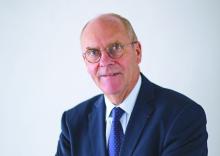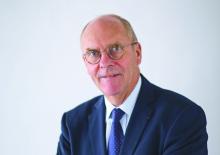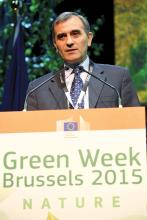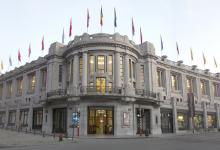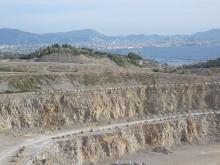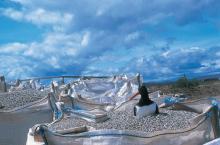
The new president of the European Aggregates Association talks to Patrick Smith about his priorities and aims for his term in office
Arnaud Colson, a 59-years-old Frenchman, is public affairs and sustainable development director at
In difficult times for many aggregates companies throughout Europe, he was elected as new president of the
Arnaud Colson succeeds Jim O’Brien who was UEPG president from 2009-2012.
In defining his Presidency priorities for UEPG, which now represents 31 countries, he says: “In the last 25 years, UEPG has progressively become a trusted industry partner in lobbying the European Union Institutions. It is essential that our industry retains its local focus, as it is vital for the development and supply of the local market, economy and community: UEPG must act accordingly.”
To improve access to mineral resources, which is still nowadays difficult in many countries, European aggregates producers steadfastly continue their commitment to environment, especially in contributing to biodiversity, to the development of recycling, to promoting health & safety and strengthening dialogue with stakeholders.
“Looking ahead, developing the aggregates industry’s vision for 2030 is indeed today vital to assuring its sustainable future.”
Colson post-graduated from the French Engineering Institute (École Nationale des Ponts et Chaussées) and auditor at the Institute of National Defence Studies (
He launched and implemented in quarries, pits and concrete production plants the environmental policy of the Lafarge Group in France, and for many years represented the French Aggregates Association (UNPG) within UEPG.
Since 2003 he had been chair of the UEPG Environment Committee and a Board Member in
Married with four children, Colson started his career in 1977 as a foreman in a civil engineering and green areas company in Dijon, France, and has been working for the Lafarge Group since 1979.
“I held different positions within the group: real estate manager until 1983; land, environment and geology manager; earthworks manager in 1986, and then environment and mineral resources director in 1998 during the merger of Lafarge with the Redland Group,” said Colson.
“I afterwards created the network of environment managers in France, which gathers now 60 experts responsible for the implementation of the environmental policy of Lafarge in France.
“Since 2008 I have been public affairs director for Lafarge Aggregates & Concrete for France. It consists mainly in implementing a policy based on sustainable development with our partners, such as NGOs, in order to secure a local access to mineral resources.
“I have furthermore been involved in the different management committees of UNPG and
He says that apart from the internal work within the Lafarge Group in France, his biggest achievement would probably be the implementation of a quarry rehabilitation policy worldwide in 2000 and the creation of a relationship with the technical and political stakeholders with the group’s active participation in
A member of the Seine Normandie River Basin Committee, a legislative body in France which defines water management in partnership with all stakeholders, Colson is a representative of this organisation on behalf of UNICEM.
“Our industry consists mainly of SMEs, operating very much at local level. Our industry is vital for local economic development: however environmental and health and safety standards must be properly implemented all over Europe.
UEPG is committed to make further progress in this area.
“Environment and safety must be the two pillars on which a sustainable access to resources relies.
“When it comes to environment, many countries have made tremendous efforts in the recent years and most notably for biodiversity.
“Investing in environmental protection and being a champion in biodiversity is not for free. Regrettably the constraints are getting stronger. We need to obtain better acknowledgement of our efforts by ways of facilitating access to resources.”
Colson says that during his Presidency his first priority will be to facilitate local access to mineral resources.
“This is essential for the ensure a sustainable supply. Some tools already exist, such as the EC Raw Materials Strategy, but we need to further assist in developing and implementing efficient national minerals planning policies.
“Access to resources is not defined at European level, which leads to great differences among our members. In some countries the permitting process is extremely complex and long and it can take ten years for a company to obtain a licence. At a time when responsiveness is a key element of competitiveness, it is necessary to promote a one-stop solution, for example.
“My second priority will be to further strengthen the industry’s commitments for health and safety. We are still far from our zero fatality objective.
“Therefore, my goal is to encourage UEPG members to promote further fatality prevention initiatives. We need reliable data in all the countries, and to analyse them in order to measure the progress made.
“My third priority will be to consolidate and strengthen the greatly enlarged network of UEPG, now composed of members in 31 countries. UEPG will assist in setting up new and fostering existing national associations.
“Progress can be observed, but only a nationally well-organised sector can defend its interests in capital cities and raise its voice in Europe. A new Communication Policy; publicly available policy positions and a new website will sharpen UEPG’s profile as a dynamic European association being at the service of its clients, the members.
“We shall continue to work closely with the other non-energy extractive industry sector associations (NEEIP) to strengthen our position on common areas of interest as we successfully did on influencing the Raw Materials Strategy Report of the European Parliament.”
He underlined that about 90% of the European aggregates industry is made up of small and medium-sized producers, which together constitute the biggest non-energy extractive industry sector.
“The challenge remains for the sector as a whole that despite the much better image of the aggregates industry and the compatibility of extractive activities and environmental protection, access to resources is handled more and more restrictively.”
Looking ahead to the industry’s vision for 2030, Colson says that it focuses on four points.
One is to support the real implementation of the EU Raw Materials Strategy notably by promoting a sustainable local supply of aggregates and by fostering recycling of aggregates where economically and environmentally feasible. The aggregates industry is a local one, essential for the local economy.
Another is to reduce the NIMBY [not in my back yard] effect by further improving the image of the sector and by communicating the benefits of the industry to local communities, and also to apply good environmental practices, which includes the implementation of the UEPG Letter of Intent signed with IUCN (
The fourth point is to ensure safe and social progress by promoting and disseminating Safer by Design and the NePSi (European Network for Silica) Reporting.
Indeed, Colson says that among the most significant achievements he would mention the voluntary social agreement on crystalline silica signed in 2006, which aims to prevent the risk of exposure to this substance for workers.
“I would also mention our success in 2008 with the Mining Waste Directive. Thanks to a constructive dialogue with the involved stakeholders, UEPG and the aggregates industry can participate in the implementation process of the Water Framework Directive and of the Marine Strategy Framework Directive.
“With EPRA (the European Platform for Recycled Aggregates), UEPG encourages more recycling while broadening the debate to the supply of raw materials and of aggregates in Europe, therefore contributing to the European strategy for resource efficiency.
“UEPG is very proud of the Safer by Design initiative. The initiative aims at convincing the producers of machinery and equipment to include more safety devices adapted to the industry thus preventing accidents.”
Initiated by the
“By participating very actively in the European Commission Raw Materials Strategy, UEPG was able to demonstrate to European stakeholders the importance of aggregates for construction and for the economy. The points developed in the report commissioned to the Austrian University of Leoben, were recognised by all relevant stakeholders.
“The European Parliament concluded that resource taxation would not be a good way to increase resource efficiency.
“Regarding the environment, and more particularly regarding biodiversity, UEPG is acknowledged as a key stakeholder both by the European institutions and by NGOs.
“UEPG was the first industry association to join the Countdown 2010 campaign led by the IUCN in 2007, and to join the Business@Biodiversity platform led by the European Commission in 2010.
“The 24,000 quarries and pits all over Europe are recognised as potential havens for biodiversity.
“I would mention the Sustainable Development Awards, created in 1996. With an independent jury this competition rewards every three years the best examples in the three pillars of sustainable development: environmental, social and economic. A fifth edition of the awards will take place in 2013.”
UEPG MEMBERS ARE THE KEY
Arnaud Colson says that the biggest strength of UEPG is its members, with four committees and four task forces dedicated to progress on key topics of the aggregates industry.
The Economic Committee is chaired by Hans-Peter Braus from Germany; Technical Committee, chaired by Jean-Marc Vanbelle (Belgium); Health & Safety Committee, chaired by Martin Isles (UK), and Environment Committee, chaired by François Pétry (France). Recycling, the EPRA, which is chaired by The Marine Aggregates Task Force is chaired by Jeffrey Thompson (Germany); Biodiversity Task Force, chaired by François Pétry (France); Water Management Task Force, chaired by César Luaces Frades (Spain) and PR and Communication Task Force, chaired by Robert Wasserbacher (Austria).
The UEPG created, together with the International Federation for Brian James, UK.
“Our permanent and dynamic team in Brussels is based next to the European Parliament dedicating, with success, its limited resources to lobbying the European institutions and to advocate for its members,” says Colson.

